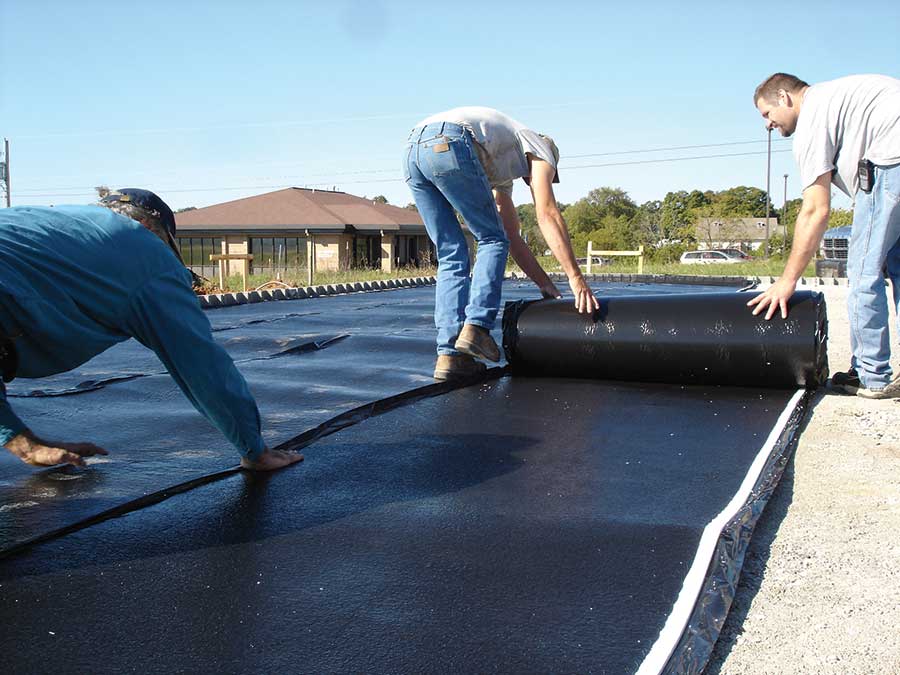A number of waterproofing and drainage products are specifically formulated for ICFs, and will help ensure below-grade jobs stay dry.
For below-grade walls, the most effective solution is a waterproofing membrane—either a spray-applied water-based system or a peel-and-stick sheet good—coupled with a drainage component to relieve hydrostatic pressure, such as a dimpled drainage sheet. (For more information, see “Foolproof Waterproofing for Below-Grade Walls” in the April 2006 issue or online at
www.icfmag.com).
Many builders, however, fail to consider the importance of waterproofing under the slab, which is especially critical in ICF construction.
“Moisture barriers are one of the single most neglected materials we see in the building trade in general,” says Juan Garcia, a noted energy and building consultant. “People pay close attention to vapor proofing and housewraps above grade, but they often completely ignore below grade aspects, especially under the slab, which is very unfortunate.” Garcia notes that when properly installed, underslab barriers can help in multiple areas.
Purposes
First, they should prevent moisture from penetrating the slab. Even if below-grade walls are properly waterproofed, the occupant could still have a damp living environment if moisture is allowed to wick through the concrete slab.
“In every instance, a moisture barrier should be put down,” claims Wally Radjenovic, president of Northwestern Ohio Foam Products. “Concrete does, through capillary action, pull water from the soil—even if the soil doesn’t appear particularly damp. The white chalky finish you sometimes see on a slab is actually material from the concrete precipitated on the surface by moisture.”
One easy way to test for this problem is to tape down a sheet of plastic a few square feet in size to the concrete. Leave it in place for 24 hours before removing it. If the concrete looks or feels damp under the plastic, a vapor barrier should have been installed.
In some regions, water vapor isn’t the largest concern. Radon, a colorless, odorless, but highly poisonous gas, can also penetrate concrete. “Radon is generated from underground uranium deposits,” explains Dwight Walker, an engineering and technical representative for Cosella-Dorken. “Water vapor may create damp conditions, but radon can be life-threatening.” Radon is of particular concern in ICF construction because the building envelope is virtually airtight, allowing the gas to build up in greater concentrations.
“U.S. residential codes, such as the IRC, require underslab moisture barriers in most instances,” notes Walker. “Section R-506 titled ‘Concrete floors on ground’ requires that whether the slab is on gravel or native soils, there needs to be a vapor barrier under the concrete.” Canadian codes require barriers only for slabs placed on native soils. Significantly, the U.S. code says underslab barriers can be omitted from garages, unheated structures, or if okayed by local building officials based on site conditions.
ASTM E-1745 sets the material standard: an impermeable sheet at least 6 mils thick with a 6-inch overlap at the seams.
Options Available
“A good underslab vapor barrier should be made from a high-quality polyethylene plastic,” says Garcia. “It should be solid and should not break down over time, so avoid canvas or any other woven-type materials. Anything that has a hatchwork or a weave is subject to permeation.”
One popular underslab barrier is Viper VaporCheck, a triple-ply, extrusion coated, virgin polyethylene membrane manufactured by InsulationSolutions.
Bright orange in color, it’s available in three different thicknesses: 6.5 mil, 10 mil, and 16 mil and comes in rolls 12’ wide x 200’ long.
Dario Lamberti, product manager for the Moisture Control Division at the company, says all three thicknesses are considered “Class A” products according to ASTM standards, and that the heavier materials are intended primarily to withstand the heavy construction traffic on commercial jobsites.
InsulationSolutions also markets Viper Vapor Tape, a cold weather adhesive tape made out of the same material for extra moisture protection at seams, and Viper VaporPatch, specifically designed for pipe extrusion patchwork.
For jobs that require a thermal barrier, InsulationSolutions makes Insul-Tarp, which uses closed-cell foam and bubble pack to achieve a flexible layer of insulation under the slab.
Cosella-Dorken’s popular Delta MS dimple membrane is also suitable for underslab work. “The big advantage is that it’s 20 or 24 mils thick where code requires 6 mils,” says Walker. “It’s durable enough to survive construction and will actually function as a vapor retarder.”
Walker notes that there is an ASTM requirement for plastics in contact with alkaline (e.g. concrete) or soil chemicals. “Contractors unaware of this may buy the wrong polyethylene and have it break down in 4 or 5 years.”
With Delta MS, the dimples overlap at the standard six inches and the concrete holds the barrier in place. Although code does not require taped seams for vapor retarders, the ASTM standard recommends it. “For radon control, seams must be sealed, and Cosella-Dorken requires it as part of their installation as a radon barrier,” says Walker.
A few products on the market can provide a vapor, moisture, thermal and sound barrier in a single product. Thermal barriers are critical if the slab is heated with hydronic or electric radiant heat, and any situation where extreme energy efficiency is called for. An insulated slab has the additional benefit of staying closer in temperature to the air instead of the soil below it.
Northwestern Ohio Foam has three products that perform these multiple functions. “The Barrier comes in 4’x60’ rolls, and consists of a 3/8 flexible foam core laminated between two sheets of 3 mil polyethylene plastic,” says Radjenovic at Northwestern Ohio Foam. The Barrier HD has a 10 mil film on the top for better moisture and puncture resistance. Barrier XT has a ¾ inch foam core that doubles the insulation value.”
The foam core is flexible, so it won’t crack when walked on, and all of the products come with self-taping edges at the seam, to eliminate all penetrations.
Garcia says that it is possible to create thermal barriers using other products but it’s not as effective. “Usually you see a combination of multiple components, traditionally a 5-mil vapor barrier with rigid foam board on the top. Even though they only need a thin layer of foam, thin boards break up, so they use 2” foam boards then another vapor barrier on top. There’s a misconception that they do it for thermal considerations, but insulation values level out; after an inch or so of foam, they’re basically throwing their money away.”
How To Install
Installation of underslab barriers is fairly straightforward. After the subgrade has been leveled and prepared, the material is rolled out and cut to length.
“You should design the layout to minimize seams, and allow extra material for the edges and any low lying areas,” says Garcia. “Seams are always an issue, and even architects will tell you they give an allowance for energy loss on seamage.”
The new ASTM standard for seam overlap is 6”, increased from 4” previously (See ASTM E-1643 Standard Practice for Installation of Water Vapor Retarders Used in Contact with Earth or Granular Fill Under Concrete Slabs). This wider seam will eliminate virtually all water vapor, as it will condense onto the barrier as it travels horizontally. Lamberti, at
InsulationSolutions, says, “If you tape them correctly, there will be no difference in permeability rating.”
If the barrier is expected to function as a radon or methane barrier, installation is more complex. Lamberti notes that radon and methane molecules are larger than water molecules, but the level of detailing is much higher. Lamberti notes that “the lower the water vapor permeance rating of a material, the more resistive it is to radon and methane.”

The Barrier makes it easy to install a moisture, vapor and thermal barrier in a single product. Just unroll, tape and seal.
“The detailing is completely different as a radon barrier versus a simple vapor retarder,” confirms Walker at Cosella-Dorken. “The membrane must be sealed around any penetrations, and some sort of mechanical ventilation system may also be needed.”
Once the barrier is in place and the seams are taped, the concrete can be placed as usual. Radjenovic cautions, “You do have to be more careful with curing when a moisture barrier goes down, because virtually no water is lost to the subgrade.”
With careful installation and the right product, underslab moisture and vapor barriers will help the ICF building envelope perform even more efficiently, eliminate moisture problems, and create greater indoor comfort.
















